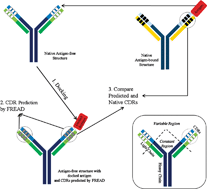Antibodies are used extensively in medical and biological research. Their complementarity determining regions (CDRs) define the majority of their antigen binding functionality. CDR structures have been intensively studied and classified (canonical structures). Here we show that CDR structure prediction is no different from the standard loop structure prediction problem and predict them without classification. FREAD, a successful database loop prediction technique, is able to produce accurate predictions for all CDR loops (0.81, 0.42, 0.96, 0.98, 0.88 and 2.25 Å RMSD for CDR-L1 to CDR-H3). In order to overcome the relatively poor predictions of CDR-H3, we developed two variants of FREAD, one focused on sequence similarity (FREAD-S) and another which includes contact information (ConFREAD). Both of the methods improve accuracy for CDR-H3 to 1.34 Å and 1.23 Å respectively. The FREAD variants are also tested on homology models and compared to RosettaAntibody (CDR-H3 prediction on models: 1.98 and 2.62 Å for ConFREAD and RosettaAntibody respectively). CDRs are known to change their structural conformations upon binding the antigen. Traditional CDR classifications are based on sequence similarity and do not account for such environment changes. Using a set of antigen-free and antigen-bound structures, we compared our FREAD variants. ConFREAD which includes contact information successfully discriminates the bound and unbound CDR structures and achieves an accuracy of 1.35 Å for bound structures of CDR-H3.

You have access to this article
 Please wait while we load your content...
Something went wrong. Try again?
Please wait while we load your content...
Something went wrong. Try again?


 Please wait while we load your content...
Please wait while we load your content...